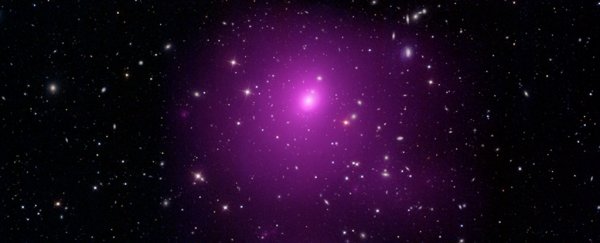Black holes can get pretty big, but there's a special class that is the biggest of the big, absolute yawning monster black holes. And astronomers seem to have identified an absolute specimen, clocking in at 40 billion times the mass of the Sun.
It's at the centre of a galaxy called Holmberg 15A, a supergiant elliptical galaxy around 700 million light-years away, which in turn sits at the centre of the Abell 85 galaxy cluster.
The object is one of the biggest black holes ever found, and the biggest found by tracking the movement of the stars around it.
Previous calculations based on the dynamics of the galaxy and the cluster had resulted in Holm 15A* mass estimates of up to 310 billion times the mass of the Sun. However, these were all indirect measurements of the black hole. This new research marks the first direct measurement; the paper has been submitted to The Astrophysical Journal, and awaits peer review.
"We use orbit-based, axisymmetric Schwarzschild models to analyse the stellar kinematics of Holm 15A from new high-resolution, wide-field spectral observations obtained with MUSE at the VLT. We find a supermassive black hole (SMBH) with a mass of (4.0 ± 0.80) × 1010 solar masses at the center of Holm 15A," the researchers wrote in their paper.
"This is the most massive black hole with a direct dynamical detection in the local Universe."
Now, it's not the most massive black hole ever detected - that would be the quasar TON 618, which apparently has a black hole clocking in at 66 billion times the mass of the Sun, based on indirect measurements.
But Holm 15A* is up there. At 40 billion solar masses, the black hole's event horizon (also known as the Schwarzschild radius) would be huge, engulfing the orbits of all the planets in the Solar System, and then some.
Quite a lot of some. Pluto is, on average, 39.5 astronomical units (AU) from the Sun. The heliopause - where the solar wind is no longer strong enough to push against interstellar space - is thought to be around 123 AU.
At the mass of Holm 15A* as determined by the new paper, its Schwarzschild radius would be around 790 AU.
Try to imagine something that size. The mind reels.
In fact, it's even bigger than other measurements taken by the researchers have suggested - which may explain why Holm 15A*'s mass has been difficult to pin down via indirect methods.
"The SMBH of Holm 15A is not only the most massive one to date, it is also four to nine times larger than expected given the galaxy's bulge stellar mass and the galaxy's stellar velocity dispersion," the researchers wrote.
However, it fits the model of a collision between two early-type galaxies with depleted cores. That's when there are not many stars in the core, based on what is expected from the number of stars in the outer regions of the galaxy.
"We find that black hole masses in cored galaxies, including Holm 15A, scale inversely with the central stellar surface brightness and mass density, respectively," the researchers wrote.
They intend to continue studying the breathtaking beast, conducting more complex and detailed modelling and comparing their results against their observations, to try to figure out exactly how the black hole formed.
In turn, that can help figure out how often such a merger takes place - and therefore how many such ultramassive black holes are yet to be discovered.
The research has been submitted to The Astrophysical Journal, and is available on arXiv.
